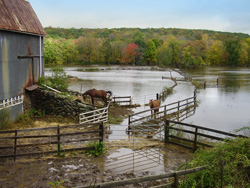Impact of climate change on waterborne viruses
The 'Impact of climate change on the transport, fate, and risk management of viral pathogens in water' (VIROCLIME)(opens in new window) initiative studied the risk to water usersposed by viruses following the effects of climate change. The results were based on samplescollected fromfive globally important case study sites, in Brazil, Greece, Hungary, Spain and Sweden. Thesewere used to obtain baseline data regarding the incidence and type of target viruses found there. Project partners studied the relationship between waterborne viruses of importance in human disease, particularly those considered to be emerging pathogens or used as viral indicators of sewage pollution. They then studiedthe predicted effects of changes in climate at important sites in the Amazon Basin and the EU. This information was used to determine possible effects on the health of individuals in these areas who may use the water, either for recreation or fordrinking water abstraction. Researchers used microbial source tracking (MST) to detect and discriminate between human and animal viruses in polluted water.Given that water pollution by sewage and run-off from farms can present a health risk, MST was used to reveal a range of different animal viruses at the sites and made it possible to distinguish between human and animal pollution. One reason why viruses represent a potential problem is that they are resistant to environmental degradation and are more robust than many bacteria. Further, bacterial faecal indicator analysis often showsvarying relationships with virus levels and may not reveal the true relationships between changes in virus concentration in water and risk to public health caused by activities such as bathing in polluted water or consumption of shellfish. Hydrological modelling of water catchments was used to determine stream flow patterns and to predict changes in river flows due to climate change, especially rainfall. Models were also used to predict changes in virus levels at the case study sites and to develop quantitative microbiological risk assessments to discover any increased risk associated with water use. The work carried out by the VIROCLIME consortium provided valuable information and new knowledge on the epidemiology of waterborne viral diseases. Different scenarios were developed thatwill support the work of policymakers, scientists and healthcare professionals.







